-
Books of the year and feelings like that
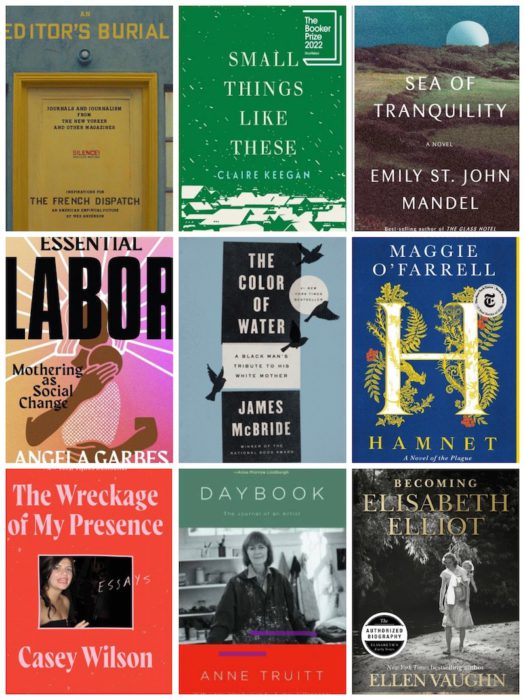
I spent an evening chasing the titles of the books I read this year. I thought there were a myriad of apps tracking this for me, in addition to my library accounts, and perhaps Amazon kindle had my digital rentals as well? But: no. None of them kept up! What are internet cookies* for anyway?
Anyway, I went about looking for signs to recall what I was reading—email mentions, texts, photos, Instagram stories. I wondered if I had read 30 books this year (nearly, somewhere around 28). Then I wrote them all down on a piece of paper in a journal. Foolproof!
Here are some of the books that passed the attention gauntlet, and won their place in my hands and flighty mind for the duration of their pages. They were all great, or I wouldn’t have finished them.
Going to take my Marie Kondo moment and say: Thank you books, for being part of my year.
More than a few peculiar memoirs this year, mostly because I fell completely for Anne Truitt’s four books that are edited journals about her life as a sculptor and doting mother. I loved the way she cataloged work as a sculptor alongside housekeeping, being a single mother, and life. I loved learning from how incredibly hard she worked at the work, even when her art was not selling or getting critical reception. I loved entering her mind at different ages and stages in her life, from her 40s. These books inspired me in my own writing, because the way she wove daily life together with meta-aspirations is exactly the type of writing I love to do.
For those of us who grew up hearing Elisabeth Elliot on the radio, hearing about she and Jim from church mission culture, or simply reading her books, the book Becoming Elisabeth Elliot was an incredible read. Through extensive journal excerpts and letters (so many letters!) the author documents how Elisabeth became one of history’s extraordinary persons, through her devotion to God and the moral framework she believed in.
Amazing fiction of the year were Hamnet, Olive Kitteridge, Small Things Like These (the slimmest, most elegant novella set in Ireland) and The Candy House.
The Candy House is on a lot of the best books of this year lists. It’s a surprisingly easy read about a future where people upload their memories to connect with one another, written from nine (maybe? I lost count) different intertwining perspectives. Like another of her books, A Visit from the Good Squad, it’s written with this light spirit and is somehow pleasant and funny while tussling with this dark sci-fi premise. Note you do not need to read Visit from the Goon Squad first.
Similarly light yet deeply thoughtful, the sci-fi books Station 11 and Sea of Tranquility were two of my favorite books of the year. If you read Station 11, you then get to watch the hbo series which has amazing costumes and fascinating twists on the original plot.
In April Joe and I went to the warm white sands of Canouan island for my older brother’s epic 40th birthday party. The hotel, Soho House, felt like a gorgeous open air home run by an invisible benevolent being, and the lobby had small piles of chic worn beach reads for the taking. There I found The Wreckage of My Presence a hilarious memoir about mothers, being a mother, and love in general. So happy and SO sad at times. Don’t want to give too much away, but it’s an amazing read, terry clothed beach lounger not required.
I picked up Lessons by Gisele Buchen at a summer used book tent sale, the type with cardboard boxes lining tables setup over lawns and under tents. Somehow I finished it just as she and Tom Brady divorced. Sad timing! I enjoyed reading about her modeling career and all her hard work inspired by her parents’ faith in her. If you read the book you learn she values family more than anything, so I can only imagine how heartbreaking that divorce was.
At one point this year I did a send-a-book chain on Instagram. I have no idea how it worked out for the 40ish people who signed up but I did my best to maximize the system by mixing up the names instead of putting them into one-chain pyramid with me at the top (as most chain letters are structured). Through that I received 8 books from strangers and really enjoyed 3 of them: Panchinko, Untamed, and The Color of Water. I loved The Color of Water, it was astounding how his mother had shaped their family, and how much he admired her, while he was also honest about how difficult his childhood was.
In January we knew we were going to Paris and Croatia in the early summer, and some reading was influenced by that. Joe and I both loved An Editor’s Burial which is a collection of stories that inspired Wes Anderson while he was writing The French Dispatch screenplay. Arguably his inspiration is better than the actual film; An Editor’s Burial is filled with gems. For Croatia I read Balkan Ghosts, a fascinating collection of essays about the different Balkan countries. And Lea Ypi’s Freedom, about growing up in Albania (which bizarrely is directly across a slim sea from Italy, but seems a world apart).
First book of last year was a re-read that I could read every year for the rest of my life: Circe by Madeline Miller. Last book of 2022 was Essential Labor: Mothering as Social Change an absolutely beautiful and thoughtful book about the kinds of care we have around us, and what we offer one another. I would recommend it to anyone, mother or not.
*Speaking of cookies, I couldn’t decide how to best hyperlink these books. Most of them are linked to Bookshop, which has a nice interface and is a place you could buy the book. But realistically what you need, as a reader, is a hyperlink where you could add these to a to-read list and get them from your library. I’m not sure where you should do that. I think goodreads is stuck in the mud–despite knowing everything I’ve read for years now, they do not give me any good recommendations. So I’m on the hunt for a new book tracking app–I think the space is realllly ready for a cute enthusiastic app that makes you want to read and helps you keep nice lists! Right now I am trying out the app Storygraph.
-
a month of so off instagram & energy bites
Deleting instagram off my phone ended up being a delightfully simple switch-up for January. My thumb hovered over the vacant spot for the first couple of days. Soon my reclaimed moments seemed to accrue and I found myself finishing more books. I read so many good books that I am now posting my recent favorite reads on the sidebar of this blog! If you click on any of them, you will find a 1-2 sentence review on my bookshop page.
I also discovered that Libby, the e-borrow service that most libraries use, has a “Lucky Day” feature where requested books popup for quick rental. That was how I was able to read Samantha Power’s The Education of an Idealist, for which I had been on a seemingly endless waitlist.
I also experienced a faint untethering. In my mind I felt suddenly self-sufficient, wholly encompassed, like a human on a walk through a forest, or a swimmer on her own in the waves. Mentally things felt quieter and more expansive. It is the case with social media on handheld technology that neither the developers nor the users understand what exactly is going on. There is no easy division between participation and absence. It feels like we have to be aware of our own state, and make decisions on an ongoing basis for ourselves.
I did miss keeping up with people, in an old fashioned way—moves, babies, marriages, the news of their lives! I definitely felt less connected to certain people and missed having a visual, present sense of what their lives looked like. One evening I logged onto my browser, hoping to catch up on news, and I was flooded with posts from business accounts. It took ten minutes just to see another individual human that I followed. That surprised me–had I just been scrolling past these accounts all along? I unfollowed a bunch of those accounts on the spot.
In similar bite-size capsule theme, I want to share with you a recipe from the new Mennonite cookbook, Sustainable Kitchen. Sustainable Kitchen came out in September, and I purchased it right away because the authors are Vermont neighbors, and Mennonite cookbooks have had a place on my shelves ever since we were given four copies of More with Less when Joe and I married.
Sustainable Kitchen is a remarkable book. The authors intended it it to work as a stand alone resource, no background googling needed (in fact, one of the authors makes a point of not having internet access at her home). There are recipes for making your own tortillas, nut butters, tahini, basic canning techniques, and a guide to beginning a compost pile. It is a plant-based cookbook, and none of the recipes use white sugar, only a few use white flour.
The authors also make a strong case for valuing what you eat as an effective everyday way to impact climate change. The more I read about carbon sequestering and watch documentaries like Biggest Little Farm and Kiss the Ground, the more I realize how the time I spend thinking through menus and ways to waste less each week IS important and worth it.
I’ve made these energy balls a few times and dropped off jars of them alongside children for playdates, as a thank you snack for gluten-free, dairy-free friends. They are very kid friendly, but adults looking for a smart snack may very well eat them first. The touches of sweet, cranberry and mini chocolate chips, are absolutely delicious, and the texture is perfectly balanced.
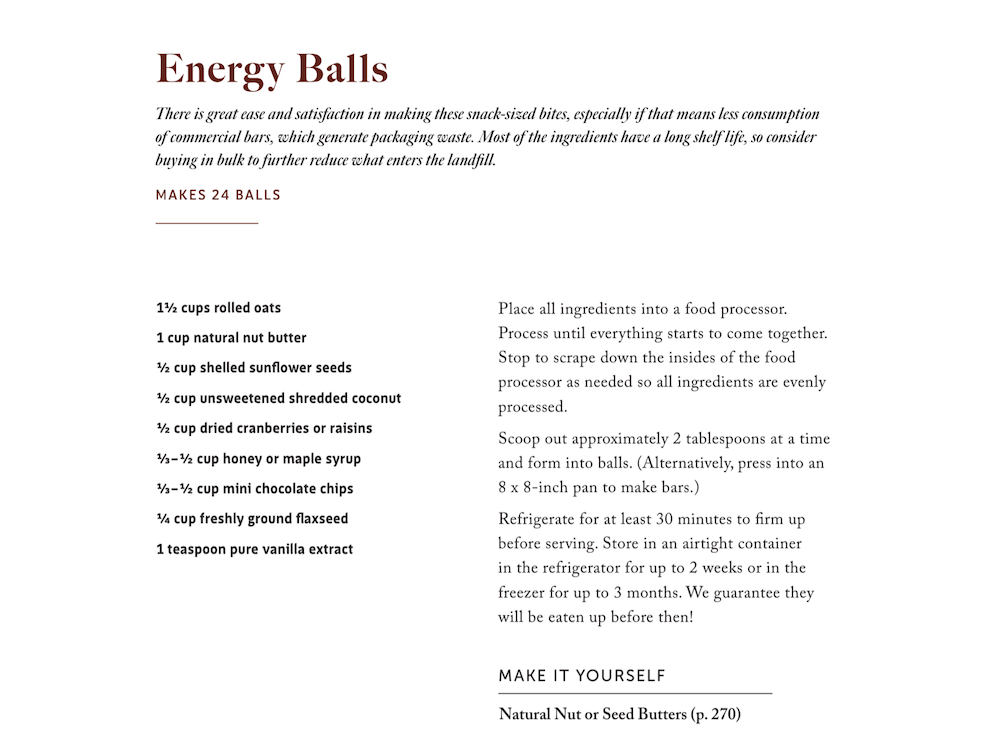
-
a quiet, working-mom christmas book on my mind
Our Thanksgiving was a lonely one and this time is terrible and I can’t wait, my children can’t wait, until we’re back to not having overflowing hospitals and exhausted nurses. I’m following the vaccine news a bit and I feel optimistic about April (my birthday month!).
And I’m including a photo of our graham cracker houses from last year but Joe built these, I did not. I made the royal icing, which was really fun to make with dangerous egg whites, but I did not cut graham crackers precisely, with an exacto knife. Just so you know.




The Jesus Storybook Bible by Sally Lloyd Jones was given to me when I was pregnant with our first daughter. I have read it aloud to all of the girls through the years, but perhaps more importantly, I’ve played the audiobook for on repeat over the years. The audiobook is wonderful. The cds are often included in the purchase of this illustrated Bible (look for “with CDs” in the listing). The storytelling approach and enthusiasm in this retelling is the best.
-
the birthday edition
 Here I am, 35. Weaning my fourth daughter, thinking about buying a lamb. Saying “last baby,” in the way that people who believe in last babies say, because they want to see it coming and say goodbye.
Here I am, 35. Weaning my fourth daughter, thinking about buying a lamb. Saying “last baby,” in the way that people who believe in last babies say, because they want to see it coming and say goodbye.Baking bread, simmering beans. Wish I cared less about messy corners.
Once I believed in no shampoo. Once I believed in all shampoo. Now I believe your body changes what it needs and you should look in the mirror and decide then.
Did I ask for anything for my birthday? yes. I asked for new slippers because I wore mine nearly every day last year and they simply gave up on day 360. I asked for oysters and a cake by mail. I received a handwritten book (“My Story” by Lux Ringenberg), a cherry wood platter sanded to gentleness by Joan, and a small box for my drawer of chaos crafted from wood and glue by Alma. There was also a sawdust cake topped with real candles and sprinkles (ferried away from the kitchen without my noticing), with frosting made from flour and water.
This week the girls learned about valkyries and watched The Ring Cycle opera which is available on the Metropolitan Opera’s streaming service. The fact that the Met has a streaming service is a thing I never would have bothered to google if not for this being week six of family quarantine. Thanks to Ronia (Netflix/Astrid Lindgren) the girls already love harpies. The valkyries seem to be an even fiercer inspiration for them to contemplate.
I did not watch it with them but I listened from the other room and overheard the selective reading aloud of subtitles. “Giant. I think that’s a giant? ‘Unless you are honest and keep your word. A simple minded giant tells you this–wise woman, heed what he says.'”
I came in to watch a few minutes. “Mom, you’ll love this, it’s so cool. It’s freezing cool.” said the four-year-old who cannot read subtitles.
If you can’t make a list of what you love in life on your birthday, when can you? A few things:
I’m in love with the anti-fragility of google forms right now. I feel like everything wonderful has migrated to a google form of one sort or another. Sign up. Volunteer. Spread the news. Let me know.
example: This farmer in Southern Vermont grows the most beautiful and obscure flowering plants of all sorts in her greenhouse, and then sells them from her front yard. She has a google spreadsheet order form posted up for spring orders. Place the order, drive and get your plants sometime in May. Bunker Farm Plants (click the link in her instagram profile for the order form.)
Bon Tucson: such a classy shop that seems to carry only the most lovely things presented in the gentlest way. I so admire their style.
The cookbooks story on Tonke’s instagram account. What a pretty collection she has, and her reviews are wonderfully precise. It’s the most recent story listed.
Our monthly coffee subscription from my hometown coffeeshop Madcap (Grand Rapids, Michigan). It is the best most delicious coffee I’ve ever had, they strive to pay more than fair trade prices to their growers, they are obsessed with quality, and they ship three bags once a month. It’s been perfect for the last year and I’m so thankful for it.
Speaking of cookbooks, Tim of Lottie and Doof told me about Midnight Chicken and it’s one of the books I happened to have with me during quarantine. My quaran-team. A thoughtful reflective cookbook filled with short memory-essays and encouraging ideas. Extremely British. It is the single reason I buy more expensive butter for toast now (strictly for slathering) than I did before.
-
Papers of All Sorts
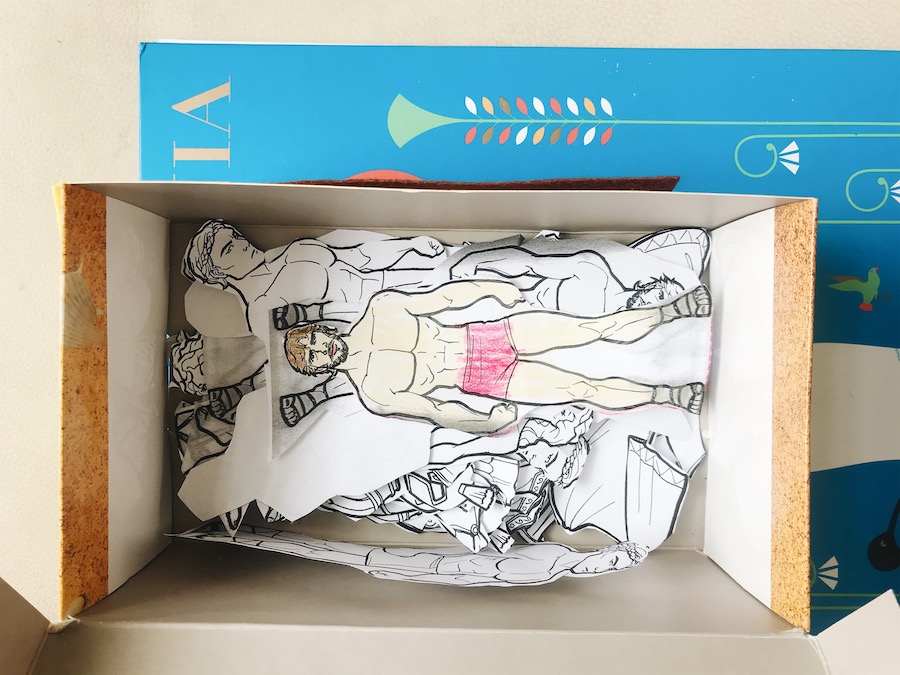

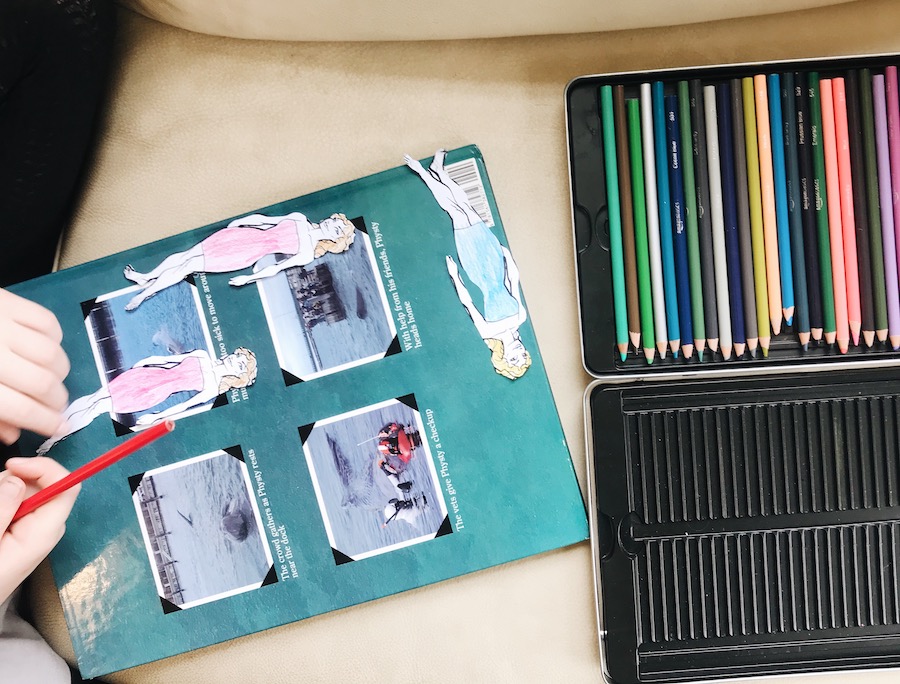
We are in day two of deep engagement with scantily clad golden age Greek paper dolls. Scraps of paper are blowing hither and thither around the house, but the girls are loving cutting and coloring these detailed creatures and as previously mentioned, I have zero better ideas. They are using ones copied out of the Story of the World Activity book, which I unfortunately can’t find scans of online. But the blog Practical Pages has fun detailed ones which you may print off for free.
I’m feeling disinterested in making meals right now. I think perhaps I’ve parceled them off too much? Taken the glamour out of the evening meal? It might be the gradually more meager supplies at the store influencing me too. Simplicity feels smart. I only want to eat pesto, bread, pink pickled onions, and cheese on repeat.
I finished my book this morning and I miss it already. Girl, Woman, Other. A collection of chapters each about a different human, often related to each other as friend, child, mother, grandmother. The writing was lovely and poetic and the chapter style made it easy to pick up and put back down. The characters were so interesting and most of their stories had quiet endings as if of course, isn’t life itself interesting enough?
I’m codependent on books right now so I’ve already ordered another. The local bookstore is offering porch drop offs (lovely!). I ordered Weather by Jenny Offill. Went for the hardcopy, because maybe Joe will want to read it too.
Aloud, I am reading the Railway Children to the girls. We love it. The writing is fabulous, and the family is isolated and self-entertaining like the rest of us.
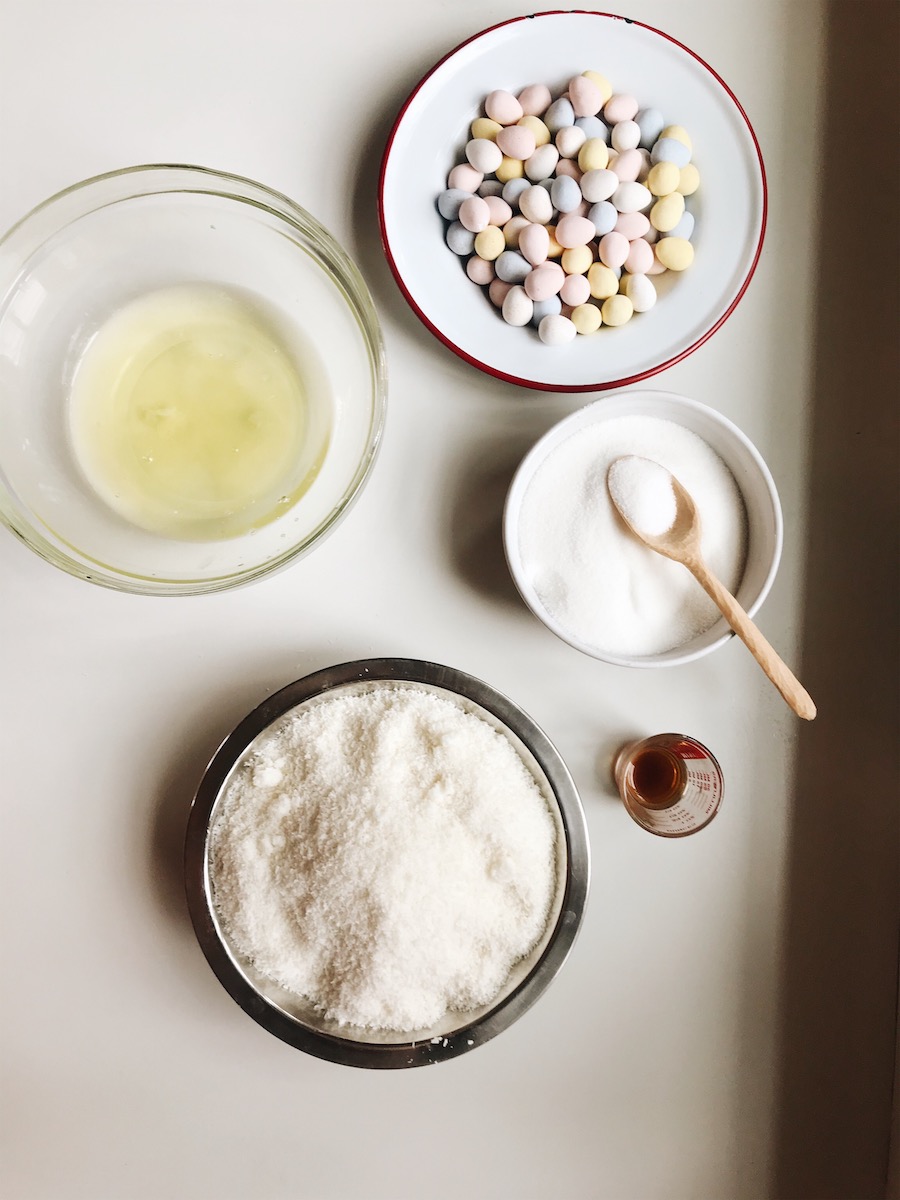

In a rare moment of prescience I bought the supplies for egg nests back in February and saved them until now. These are so easy to make but the girls turned them into a really lengthy project this time–spooning the sugar into the bowl by spoonfuls, trying different designs of nests. I typically expect projects of being 1:1:1–equal ratios of time spent setting up and cleaning up, to the time the project was actually engaging. It’s unexpected when it turns into something longer. The girls each selected one nest to save for Easter morning.
-
numbers person

Do the categories word person and numbers person truly exist? Are they separate kingdoms as in the genially absurd classic novel Phantom Tollbooth?
I always liked math in school and never questioned my competence in it. In particular I remember delighting in the requirement to circle your answer, lest it got lost amid the scribbled equations. There was this sense of the question–what if you had the right answer, but then you wandered away, and ended up circling the wrong one? The mysterious revolution–you were right, then you were wrong, but then you were right after all. It felt intimate, and I loved that part.
But I feel like a natural words person. Was this feeling assisted by simplistic duality of a printed piece of paper carrying my ACT score in which I scored higher on English than Math? Perhaps.
But there is too the fact that I do not think in numbers, nor do I puzzle over them, nor do they seem to call to me. Not in the morning, or the night, or the middle of the night. I do not so much miss them, but I do think it would be incredible to encounter numbers so familiarly that they had essence and color, as autistic savant Daniel Tammet recounted in his book years ago, Born on a Blue Day. When I make a list of human experiences I hope to have in heaven, that is top five on mine, absolutely.
Anyway, as a result of some of these things, I often puzzle over how to invite numbers generously into my children’s world. My approach to this is to read about it (ha). Basically I’m hoping to get inside the head of a numbers person so I can properly convey that magic to the girls. Lately I’ve read several books by the mathematically inclined, like A Mind for Numbers, and Surely You’re Joking, Mr. Feynman.
So when my friend Katharine recommended the new The Weil Conjectures about math and the genius siblings Simone and André Weil (pronounced “vey”), I immediately asked my library to order it.
The book is one part reminisce of the author Karen Olsson’s own brief love affair with math, a sprinkling of the writings of various mathematicians (all delightful!), and one part biography of the Weil siblings—Simone, known among Christians and philosophers for her spiritual writing, and André, unknown to me, but a brilliant mathematician.
About one of the historical mathematicians, she writes:
Poincaré characterizes math as practically a form of spontaneous combustion, “the activity in which the human mind seems to take the least from the outside world.” As such, he says, it ought to tell us something about the essence of thinking.
It is very much a genre-bending book, with historical notes blended with personal ones, and fictitious scenes recreated based on fact. I particularly enjoyed Olsson’s reflections on her emotional experience with math…
But after more than two decades, if anything my dalliance with math seems just that, a past love, one I remember with nostalgia and the kind of echo feeling that adheres to the memory of an old romance.
Also, at nineteen, so much is up in the air, open to question, unreliable. I think part of what I like about math was simply that it seemed like a sure thing, as sure as a thing could be, a solid mass of true and rigorous and irreproachable knowledge that I could grab like a pole on the bus.
Because I previously only knew of Simone Weil as a Christian spiritualist, I was initially surprised by how lightly Olsson dealt with her spiritualism in the book. But as she reveals the intensely complex and troubled character of Simone, I began to understand why encountering her spiritual writing revealed only a fraction of this woman.
One thing I’ve taken away from my reading is the sheer delight that mathematicians take in the question. Never mind the answer. It’s the question, and the possible solution, and routes to the possible solution, that are most delightful. The Weil Conjectures is most engaging when recounting Simone and André’s letters wherein Simone asks again and again for him to explain the work he does, the math he puzzles over, and he finally does. She does not understand the explanation, and she knew she wouldn’t, but his answer has been recorded for history, for us, nonetheless.
-
ann patchett’s book club

Eight months in, I’m so glad I joined Ann Patchett’s book club. The Signed First Edition Club ships a book to you each month, signed by the author. It arrives in a small cotton bag with a note from the book buyer about why she loved it. Sometimes it has a note from Ann instead, like April’s amazing galactic-friendship fiction, Lost and Wanted by Nell Freudenberger.
I once read a remark along the lines of: If you want people to buy your book, you better be buying their book. As in, if you believe in books, buy books.
And after thinking about it for a while I decided I could commit to buying a new book each month. It is a bigger commitment than one would think. Somewhere in the frame of $30 a month puts it just under our daily coffee bill (we also prefer to get beans by mail subscription. Ah, the country life.).
It’s run out of the bookstore Ann owns in Nashville. Each month the new book shows up in my post office box. Our town gives us this post office box for free because the Postal Service doesn’t come up our road. Initially, I resented this NEGLECT on the Post’s part, but soon I realized it was an enormous advantage, to not have to see your mail every day. Or only seeing it when you wanted to: as an occasion. It doesn’t make the bills less bill-y but at least it makes a stack of them to be looked through with some formality and attention. Ah the mail, I say to myself looking through them with magnanimous cheer. The magazines pile up too. And the notes. All in all, the haul is often satisfying.
Or it could be just the click of the tiny door, the dark key that the girls take turns using, and the chatting of pleasantries with the postmistress that feels nice.
Ann has a funny story on the store’s blog about getting the book club going. She used her power as a famous author-interviewer to get Tom Hanks to sign his books for the First Edition Club’s subscribers. She asked for signed J.K. Rowling copies for her members in lieu of getting paid an interview honorarium. I was very impressed by these stories. I can imagine Tom gently sighing as he signed the 600 copies she requested. Circle of publishing celebrity life, he perhaps muttered.
A few other perks: the idea of reading the book very first thing, a book you will likely end up reading eventually so you can participate with the reviews and accolades that pop up later. Maybe you’ll even notice in advance when the author comes to your town on their book tour. And you have supreme gracious lending rights: you can let a friend borrow it and almost guarantee they haven’t read the book yet.
Parnassus Signed First Edition Club
-
Spring
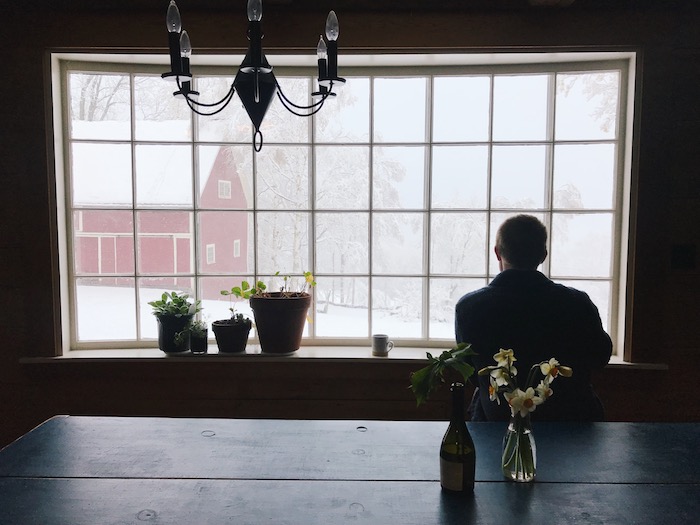
Hi! May I begin with a photo from yesterday morning: coffee and the startling snow? I messaged a friend, worried about her flowers, and she responded, they are shocked, as am I, but we’ll pull through. I loved that. Today the snow was gone and everything was greener for it.
I admit I’m having trouble getting back into the swing–the wooden tree swing–of writing here. The time constriction of life right now is very good for productivity in general, my official to-do list gets done because I only have about 60 minutes every day to do it. But other things that take and generate creative energy have been replaced by holding Esme and gazing at the ceiling, or holding Esme and reading a book, a Barbie Early Reader no doubt, that I really wish Alma hadn’t managed to slip into the library bag. And so on.
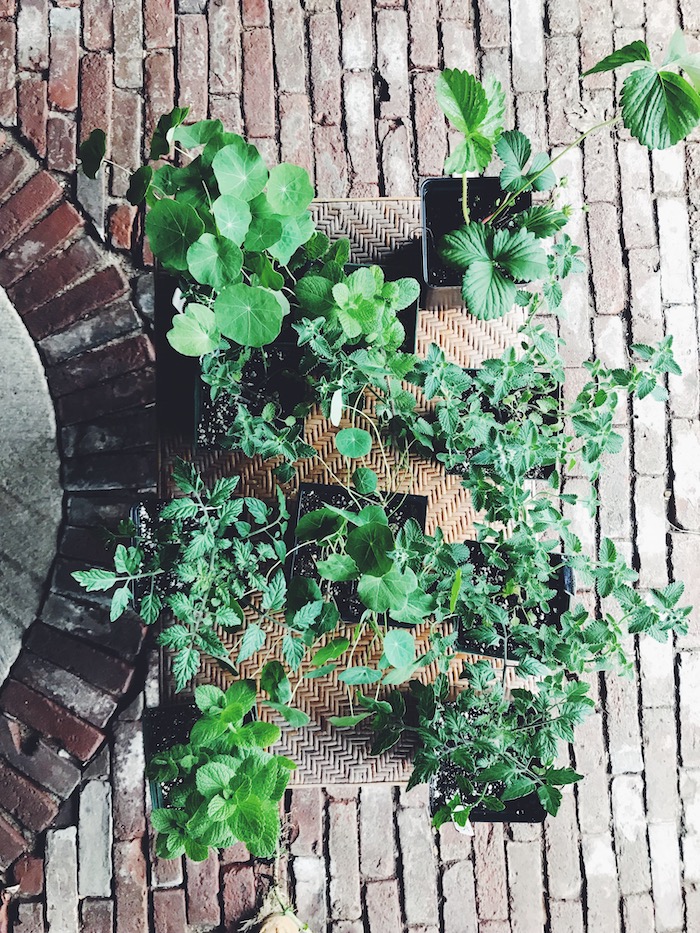
I’ve been thinking about this interview with the enchanting Katherine Paterson, author of many books including Bridge to Terabithia. Sometimes with reading to kids, I’m so eager for them to meet books that I fear pull them out too soon. Is there a ‘too soon’ though? What if you meet a character at age seven, and revisit her again at 12? Anyway, on that topic I was I intrigued to hear her say…
I do get worried when I hear parents bragging about their kid is so smart and reads so well that she’s reading Bridge to Terabithia when she’s 6 years old or 7 years old and I think, ‘No, no, no. You need happily ever after when you’re that age. You don’t need Bridge to Terabithia. There’s an emotional readiness as well as an intellectual readiness and you need to make sure that your kid is ready emotionally for the death of another child.
To be honest, the idea of “happily ever after” and children is becoming more and more foreign in today’s culture. We seem to be in a hurry to introduce every social challenge, every world socio-political issue as soon as possible, even as our children are raised with fewer personal responsibilities or chores and with less independence than what would have been allowed in previous generations. Thoughts on this? It’s something I think about a lot.
Another gem from KP on discussing books with kids: “If you know the answer to a question, then it’s not a question.” I love how that affirms talking over books with your children after they age into reading titles that you haven’t, and likely will never, read. The whole thing is worth a listen, I enjoyed it.
till next time xo
-
Bookshelf Godmothers
My friend Jenny has been homeschooling her five children from the beginning. From afar I’ve watched as her confidence and spirit have flourished in her approach. I know her as a deep thinker and researcher, so I knew she must have a heavy bookshelf of guidance and encouragement in this journey (in particular I liked imagining her on her porch, deep North Carolina summer, glass of iced tea, notepad, and books at her side).
I asked her to share the top titles with us, the bookshelf-godmothers of her approach, and she did! There is so much wisdom here. Thank you Jenny! Illustration by Joe.
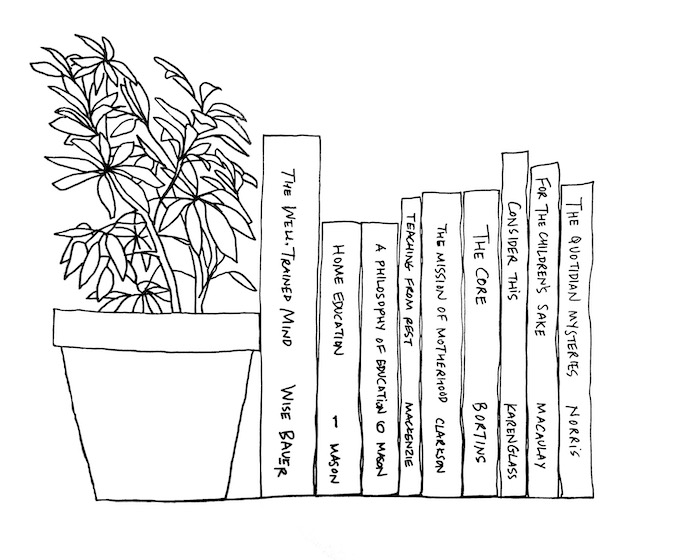
Homeschooling sort of stumbled into my lap. I never planned to be here, and I don’t know much about what the future holds. We just do the next right thing. We’ve settled now into a classical, Charlotte-Mason, history-loving, nature-school hybrid that I’ve dreamt up with my husband of 11 years. We have 5 children, a handful of chickens, 1 dog, 2 cats on 4 acres in the woods near Charlotte, NC. My husband is a financial advisor by day, homesteading park-ranger by night. We love nature and books, food and bonfires.
We have a mixed bag of influencers. Being an analytical mind and extensive researcher, I feel the need to read all the books. I enjoy the overwhelming feeling of so much good. All these women, going before us; leading the way and training us with their wisdom.
- Our first influencer, the Headmaster, Susan Wise Bauer of The Well-Trained Mind
- This is the comprehensive guide to classical education outlining the history of the methodology as well as implementation. The three stages of classical education are then thoroughly discussed by grade and subject. The book-lists alone are worth copying down. The last section discusses how to implement classical education at home, managing the records, tests and schedules, etc. No coddling. She gets right to it. Her way is strict, demanding, specific, and extensive. I open this book every summer when I’m planning my year and re-read each section for my specific child’s needs. I order most of her recommendations and haven’t been disappointed once. The Bauers and the Well Trained Mind have a large presence in our home. We’ve used:
- Story of the World– all four volumes and workbooks. Elementary history chronologically and geographically written so well.
- The Ordinary Parent’s Guide to Teaching Reading– an open-and-go phonics program. Simple and straightforward. We’ve used it for years.
- First Language Lessons– An open-and-go classical grammar and language arts program for the early elementary years.
- This is the comprehensive guide to classical education outlining the history of the methodology as well as implementation. The three stages of classical education are then thoroughly discussed by grade and subject. The book-lists alone are worth copying down. The last section discusses how to implement classical education at home, managing the records, tests and schedules, etc. No coddling. She gets right to it. Her way is strict, demanding, specific, and extensive. I open this book every summer when I’m planning my year and re-read each section for my specific child’s needs. I order most of her recommendations and haven’t been disappointed once. The Bauers and the Well Trained Mind have a large presence in our home. We’ve used:
- Charlotte Mason, specifically, Home Education Vol 1 and A Philosophy of Education Vol 6
- Here we have our wise, wordy grandmother. Using her philosophy, she led schools and trained teachers in England (in the early 1900’s). Her basic premise is best summed up in the phrase, “Education is an atmosphere, a discipline, a life.” Some of my favorite topics covered in these two volumes: living books, habits, whole living ideas, nature study, a child’s mind as an organism, a full and well-rounded curriculum full of the ‘riches,’ using short lessons to encourage interest and eliminate boredom, and how stories build character. Anyone who is interested in not doing ‘school at home’ but real and vibrant homeschool, opposite of brick-and-mortar school should consider reading both of these volumes (or all 6!). Our students are spirits to be kindled, after all.
- Sally Clarkson The Mission of Motherhood and Educating the Wholehearted Child
- If I had to choose a fairy godmother, I would choose Sally Clarkson. She has the tender loving, sweet-talking, supportive air about her. She has written a myriad of books and they range from topics of motherhood in general, homeschooling, homemaking and more. These two are my favorites. The first is an affirming, spiritually-rich encouragement for the calling of motherhood. It reminds us that our primary role as parents is the development and molding of our children’s hearts for God. Teaching them (even if we don’t school them) to tend their passions, habits, words and actions towards being faithful to God is our ultimate destiny for these short years we have them at home. The book is a yearly must-read for me, even if I just skim or read my underlining. After I close the book, I have a renewed sense as a mother. I’m more patient, calm and hopefully, more aware of being with my children instead of just managing them.
- Educating the Wholehearted Child is a homeschooling-rich resource. It outlines how the Clarksons homeschooled and how they used living books and various curricula. They discuss discipleship and use that as a term that is a good reminder for creating life-long learners modeled after Jesus’ teachings. The book reads like a textbook and is an aid for beginners as it details various homeschooling methods, curriculum and resource lists.
- Other books by Sally that I’ve read and recommend: Desperate (encouragement for the weary mom), The Lifegiving Home (yearly ways to make your home unique, inviting and traditions to uphold), and Seasons of a Mother’s Heart (a gentle reminder to take care of yourself and that certain season are more difficult than others).
- Sarah Mackenzie Teaching from Rest
- Sarah Mackenzie would also be a fairy godmother if we’re allowed two. Or a fairy aunt. She is young and still in the trenches with toddlers and students afoot. Her book is a short but concise view of the mental challenge of teaching from rest and from a space of low-anxiety. She gently reminds us who it is we are working for (God) and what is required of us (faithfulness). “The heart of this book is about remembering what our true task really is and then throwing ourselves in completely. Giving our all. The raising of children, the teaching of truth, the sharing of life, the nourishing of imagination, and the cultivating of wisdom: these are all his anyway, we are merely His servants.” This is a must-read for any new or harried homeschooler. (Her website/podcast is also full of book list nuggets and interviews with some popular authors www.readaloudrevival.com; She also has a new book out called The Read Aloud Family.)
- Kathleen Norris Quotidian Mysteries
- This one won’t show up on many homeschoolers’ radars but I consider it a yearly must-read. Kathleen Norris could be our spiritual mother and mentor. The subtitle of this very short but thoughtful read is Laundry, Liturgy and ‘Women’s Work’, and it enables us to recognize our quotidian (or daily tasks) as holy work. The repetition, the mundane and the potential acedia that takes years to overcome is all discussed in a poetic and personal tone. Dishes, laundry, mopping, brushing out tangles, all of these can be worthy as worship if done in the right spirit. This is not a homeschool book. Most days, though, the actual schooling is easy and the living is what drains me. This book convicts me to my core making me evaluate my heart and motivation. Our homes can be our monasteries. Liturgy, reading, housekeeping and constant prayer- as the Benedictines do, so do the mothers.
- Susan Schaeffer Macaulay For the Children’s Sake
- Susan Schaeffer Macaulay- a gently reminding sister. When I first came into the homeschooling arena, this book was recommended over and over to me. It is a biblically framed reminder to remove ourselves from the culture of schools and create an atmosphere of education in our home. It is a great read for the beginner, especially one who has littles at home. The pressure to start sometimes itches at us but our children need to be relieved of this. She’d say “Remember this: nourish our children’s lives and cultivate their souls.”
- Other notable recommendations: Leigh Bortins-The Core, Karen Glass- Consider This, Cindy Rollins- Mere Motherhood.
We can’t forget the men. Here are some notable Godfathers:
- C.S. Lewis- Abolition of Man
- David Hicks- Norms and Nobility
- Anthony Esolen- Ten Ways to Destroy the Imagination of your Child
- Oliver DeMille- A Thomas Jefferson Education
- Richard Louv- Last Child in the Woods
I’ve been wanting to read/currently reading: Stratford Caldecott- Beauty in the Word (amazing!), and Julie Bogart, The Brave Learner. Let us not become weary in doing good, for at the proper time, we will reap a harvest if we do not give up. Cheers to you on this long obedience; may your years reap a great harvest.
- Our first influencer, the Headmaster, Susan Wise Bauer of The Well-Trained Mind
-
review // Home Grown: Adventures in Parenting off the Beaten Path
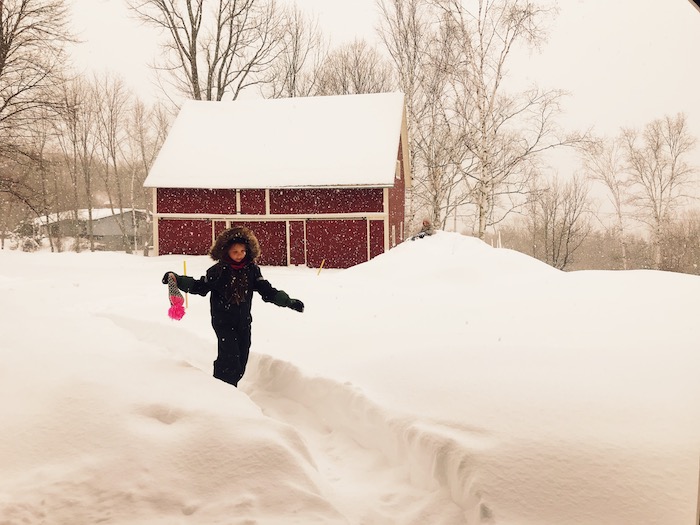
I just finished a forest school book that was so nice I’d like to read it twice. Maybe I will. It was one of those wonderful reads where you get to live in someone else’s life and soak up their lessons and foibles, their mistakes and ambitions, all from the sequestered comfort of your home that looks nothing like theirs. Here’s how I came upon the book…
A few years a guy by the name of Ben Hewitt wrote an article for Outside Magazine about unschooling. I read it through a couple times and deemed it a steaming cup of bone broth from the unschooling movement. Here’s just a paragraph or two…
By 6:30, with the first rays of sun burning through the ground-level fog, the boys are outside. At some point in the next hour, a yellow school bus will rumble past the end of the driveway that connects the farm to the town road. The bus will be full of children the boys’ age, their foreheads pressed against the glass, gazing at the unfurling landscape, the fields and hills and forests of the small working-class community they call home.
The boys will pay the bus no heed. This could be because they will be seated at the kitchen table, eating breakfast with their parents. Or it might be because they are already deep in the woods below the house, where a prolific brook trout stream sluices through a stand of balsam fir; there is an old stone bridge abutment at the stream’s edge, and the boys enjoy standing atop it, dangling fresh-dug worms into the water. Perhaps they won’t notice the bus because they are already immersed in some other project: tillering a longbow of black locust, or starting a fire over which to cook the quartet of brookies they’ve caught. They heat a flat rock at the fire’s edge, and the hot stone turns the fishes’ flesh milky white and flaky.
I immediately googled what else this guy had written, and requested his book Home Grown. It is a quieter read than the article. While the article is edited to entice, and also, yes, to provoke, the book is a thoughtful read on the endearing attempts of unschooling parents to guide and provide for their children, to be patient, to believe in themselves and their child, and their children’s recent habit of skinning skunks in the front yard. It reminded me of Wendell Berry–written in a softly humble tone by a man who is grateful and astonished to find himself supporting his family above the poverty line as a writer and farmer.
Though we may now live surrounded by trees, rest assured my children are not (yet) hunting squirrels with handmade bows or building their own maple sugaring fires. They do not wake at dawn, dress appropriately for the weather and leave the house for hours at a time. And we aren’t unschooling. We are decidedly full of workbooks and curriculum and goals. But in reading something like Home Grown I can learn a lot from his attitude, the reminder to take the extra time to let them learn alongside you, the power of wait-and-see.
It has also been on my mind to seek out a tutor of sorts who could wander the woods with the girls, so I was delighted to find this same idea working well for Ben’s family. There are loads of wonderful camps around us, but I don’t need a week of intense activity framed by long drives and packed lunches. I would love something regular in our backyard with someone who can evolve into a mentor and friend.
What about you? Any good education reads lately?